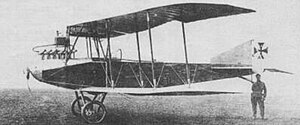| Lloyd C.II–C.IV | |
|---|---|

| |
| Lloyd C.II | |
| Role | Reconnaissance aircraftType of aircraft |
| National origin | Austria-Hungary |
| Manufacturer | Ungarische Lloyd Flugzeug und Motorenfabrik AG / Magyar Lloyd Repülőgép és motorgyár Részvény-Társaság |
| First flight | 1915 |
| Primary user | KuKLFT |
| Number built | 100 × C.II ca. 50 × C.III ca. 40 × C.IV |
The Lloyd C.II and its derivatives, the C.III and C.IV were reconnaissance aircraft produced in Austria-Hungary during the First World War. They were based on the Lloyd company's pre-war C.I design, and like it, were conventional biplanes with swept-back wings.
Design and development
After the outbreak of World War I, the original aircraft was refined somewhat by Lloyd designers Wizina and von Melczer, featuring a reduced wingspan and wing area but increased weight. An 8 mm Schwarzlose machine gun was added on a semi-circular mount for an observer.
Beginning in 1915, one hundred examples of this type were built – fifty by Lloyd at their plant in Aszód, and another fifty by WKF in Vienna.
Apart from their service with the Austro-Hungarian flying service, ten C.IIs saw service with Poland. These were captured in Malopolska in November 1918 and were used as trainers until being withdrawn from service in 1920.
The C.III was almost identical except for the use of a 120 kW (160 hp) Austro-Daimler engine, which increased the top speed to 133 km/h (83 mph). Production again was by both Lloyd and WKF, with total production amounting to 50-60 machines.
The C.IV also used the Austro-Daimler engine, and small batches were produced by both Lloyd and WKF.
Variants
- C.II with Heiro engine and 14.00 m wingspan (100 built)
- C.III with Austro-Daimler engine and 14.00 m wingspan (8 or 16 built by Lloyd, 43 by WKF)
- C.IV with Austro-Daimler engine produced by Lloyd with 14.52 m (47 ft 8 in) wingspan (47 built, plus one converted)
Operators
Specifications (C.II)
Data from Grosz 2002, German & Austro-Hungarian Aircraft Manufacturers 1908 - 1918
General characteristics
- Crew: 2
- Length: 8.8 m (28 ft 10 in)
- Upper wingspan: 14.8 m (48 ft 7 in)
- Lower wingspan: 13.8 m (45 ft 3 in)
- Height: 3.15 m (10 ft 4 in)
- Wing area: 38.0 m (409 sq ft)
- Empty weight: 900 kg (1,984 lb)
- Gross weight: 1,329 kg (2,930 lb)
- Powerplant: 1 × Hiero (Mar) 6-cyl. water-cooled in-line piston engine, 108 kW (145 hp)
Performance
- Maximum speed: 128 km/h (80 mph, 69 kn)
- Range: 400 km (250 mi, 220 nmi)
- Service ceiling: 3,000 m (9,800 ft)
- Rate of climb: 5.6 m/s (1,100 ft/min)
Armament
One 8 mm (0.315 in) Schwarzlose machine gun in the observers position, mounted on a rail.
- 90 kg (198 lb) of bombs
Notes
- Taylor 1989, 581
- Gunston 2003, 184
- ^ Grosz 2002
- Murphy 2005, 108
- Treadwell, Terry C. (2010). German & Austro-Hungarian Aircraft Manufacturers 1908 - 1918. Stroud: Amberley Publishing. pp. 268–271. ISBN 978-1-4456-0102-1.
References
- Grosz, Peter M. (2002). Austro-Hungarian Army Aircraft of World War One. Colorado: Flying Machine Press.
- Gunston, Bill (1993). World Encyclopedia of Aircraft Manufacturers. Annapolis: Naval Institute Press.
- Murphy, Justin D. (2005). Military Aircraft: Origins to 1918. Santa Barbara: ABC-Clio.
- Taylor, Michael J. H. (1989). Jane's Encyclopedia of Aviation. London: Studio Editions.
- Treadwell, Terry C. (2010). German & Austro-Hungarian Aircraft Manufacturers 1908 - 1918. Stroud: Amberley Publishing. pp. 268–271. ISBN 978-1-4456-0102-1.
| Lloyd aircraft | |
|---|---|
| KuKLFT designations: | |
| KuKLFT C-class aircraft designations | |
|---|---|
| Aviatik (Ö) | |
| Hansa-Brandenburg | |
| Knoller | |
| Lloyd | |
| Lohner | |
| Oeffag | |
| Phönix | |
| Ufag | |
| WKF | |